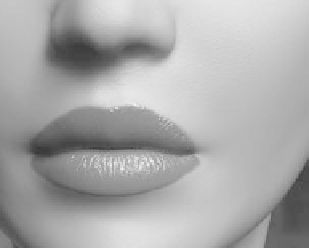Graphics Reference
In-Depth Information
(a) BRDF (b) BSSRDF
Figure 4.11
Images of a detailed human face model rendered with (a) a BRDF approximation to the
dipole model; (b) the dipole-based BSSRDF model with measured parameters for human
skin. (From [Jensen and Buhler 02] c
2002 ACM, Inc. Included here by permission.)
(See Color Plate II.)
in other ways. Consequently, ray tracing is not needed to employ the diffuse
BSSRDF model. This allowed it to be incorporated in a variety of rendering
systems, including those used in motion picture production. The elimination of
ray tracing is also advantageous for implementation in hardware shaders. A paper
by Xuejun Hao, Thomas Baby, and Amitabh Varshney shows how the dipole
model can be approximated with polynomials, and the integration over the surface
precomputed so that evaluation requires relatively little computation at run time
[Hao et al. 03].
4.3.4 Fast Translucency
A year after the publication of the dipole BSSRDF model, Jensen and Juan Buh-
ler published a paper entitled “A Rapid Hierarchical Rendering Technique for
Translucent Materials” [Jensen and Buhler 02]. What is meant by a “translucent
material” is not well defined as technical term, but it generally refers to a medium
that exhibits a high degree of scattering with strong forward bias in the scatter-
ing direction. That is, most of the scattering comes in the form of deflection of
light paths, so that the single scattered light tends to propagate in the same gen-
eral direction. In computer graphics “translucent” often implies that scattering
becomes more isotropic after multiple scattering events, i.e., becomes diffuse.
Marble, milk, and human skin (the materials studied in the 2001 BSSRDF paper)
are examples of translucent materials.
Jensen and Buhler's “fast translucency” paper begins by examining Monte
Carlo simulations of scattering in translucent materials. Figure 4.12 contains plots









